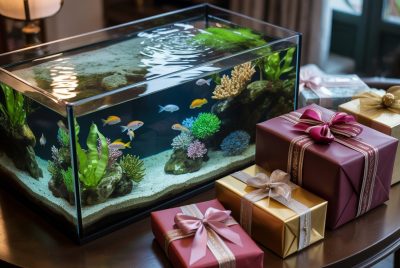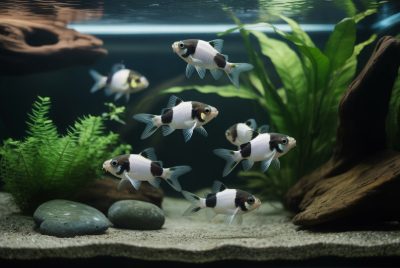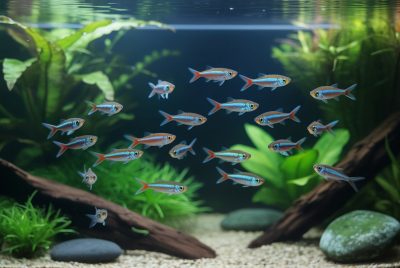7 Aquarium Filtration Mistakes Harmful to Fish
*We may earn a commission for purchases made using our links. Please see our disclosure to learn more.
My journey into the wonderful world of aquarium keeping began much like many others, with excitement, optimism, and unfortunately, a string of costly aquarium filtration mistakes. I still remember the day I discovered my prized angelfish floating lifelessly at the top of my tank, the culmination of what I would later learn was a series of critical filtration errors. That heartbreaking moment became the catalyst for my deep dive into understanding proper aquarium filtration.
Over my fifteen years of fishkeeping experience, I’ve learned that filtration isn’t just about having equipment, it’s about understanding how that equipment works and how to maintain it properly. The difference between a thriving underwater ecosystem and a toxic environment often comes down to avoiding simple but devastating aquarium filtration mistakes with your filtration system.
Whether you’re a beginner who’s just set up your first tank or a seasoned aquarist looking to troubleshoot persistent issues, this guide will help you identify and correct the most common aquarium filtration mistakes that might be silently harming your aquatic friends.
Key Takeaways
- Proper filtration is the foundation of a healthy aquarium ecosystem
- Choosing the right filter size based on tank volume and bioload is crucial
- Regular maintenance doesn’t mean complete cleaning, beneficial bacteria must be preserved
- Different fish species have specific filtration needs and water flow requirements
- Media layering impacts the efficiency of mechanical, biological, and chemical filtration
- Understanding the nitrogen cycle is essential for proper filter management
- Upgrading filtration gradually helps prevent system shock and fish stress
“The quality of your aquarium’s water is directly tied to the health of your fish. When it comes to filtration, the mistakes we make often come from good intentions but poor information.”
— Dr. Timothy Hovanec, Aquatic Microbiologist
Mistake #1: Undersizing Your Filter
The first and perhaps most common aquarium filtration mistakes I’ve seen (and made myself) is choosing a filter that’s too small for the aquarium. Early in my fishkeeping journey, I believed the recommendations on filter packaging were generous estimates rather than minimum requirements. I learned the hard way that this simply isn’t true.
“I thought I was saving money by purchasing a filter rated for 20 gallons for my 20-gallon tank,” I tell people at the local aquarium club meetings. “But I couldn’t understand why my water parameters were unstable despite regular water changes.”
The truth is, filter manufacturers typically base their ratings on ideal conditions, minimal fish load, perfect maintenance schedules, and optimal environmental factors. In real-world scenarios, you should aim for a filter rated for at least 1.5 to 2 times your actual tank volume. This provides a crucial buffer for:
- Higher fish populations than test conditions
- Accumulated waste between maintenance sessions
- Fluctuations in beneficial bacteria colonies
- Unexpected increases in bioload (such as when fish grow)
For my 55-gallon community tank, I now use a canister filter rated for 100 gallons, supplemented with a sponge filter for additional biological filtration. Since making this change, my water parameters have remained stable, and my fish display vibrant colors and active behavior, clear indicators of a healthy environment.
Mistake #2: Cleaning Your Filter Completely
One spring afternoon, during my monthly tank maintenance, I decided my filter looked particularly dirty and needed a thorough cleaning. I removed all the media, rinsed everything under hot tap water, and even scrubbed the interior with a brush to remove all the “gunk.” The filter looked brand new when I reassembled it, but within 48 hours, my water clouded, ammonia levels spiked, and I lost several fish to what I now know was “new tank syndrome.”
This devastating experience taught me one of the most crucial lessons in aquarium keeping: your filter isn’t just equipment, it’s a living ecosystem.
The brown “gunk” accumulating in your filter isn’t just waste; it contains colonies of beneficial bacteria essential for breaking down toxic ammonia into less harmful nitrates. These bacteria primarily live on your filter media surfaces, and when you clean everything at once, especially with chlorinated tap water, you’re essentially resetting your nitrogen cycle.
The proper approach to filter cleaning is:
- Never clean all media at the same time, rotate cleaning different components in successive maintenance sessions
- Only rinse media in dechlorinated water or water removed from the aquarium during a water change
- Focus on clearing physical obstructions while preserving the brownish bacterial film
- Clean mechanical filter media (sponges, floss) more frequently than biological media (ceramic rings, bio-balls)
Since adopting this approach, I’ve maintained crystal clear water without any dangerous ammonia or nitrite spikes, even in heavily stocked tanks.
Mistake #3: Ignoring Media Layering
When I first started using multi-stage filters, I would haphazardly stuff filter media wherever it would fit, not understanding that proper media layering is essential for effective filtration. This careless approach led to reduced filter efficiency and frequent clogging.
The correct sequence for filter media follows the water flow path:
- First stage (Mechanical filtration): Coarse sponge or filter floss to trap large particles
- Second stage (Mechanical/Biological): Medium-grade sponge to catch smaller debris and provide surface area for beneficial bacteria
- Third stage (Biological filtration): Ceramic rings, bio-balls, or other high-surface-area media to house nitrifying bacteria
- Final stage (Chemical filtration): Activated carbon, Purigen, or other chemical media to remove dissolved organics, medications, or discoloration
I once reversed this sequence in my canister filter, placing the fine mechanical media before the coarse media. This well-intentioned mistake caused the fine media to clog rapidly, reducing flow and creating anaerobic pockets where harmful bacteria could develop. After correcting the arrangement, my maintenance requirements decreased significantly, and water clarity improved.
For HOB (hang-on-back) filters, many come with cartridges that combine all filtration types. While convenient, these can be problematic when they need replacing, as you’re removing biological filtration along with the depleted chemical media. I’ve modified my HOB filters by adding additional biological media behind the cartridges to maintain the nitrogen cycle during cartridge changes.
Mistake #4: One-Size-Fits-All Approach to Water Flow
“My betta seems to be struggling to swim properly,” a friend once told me after setting up her first aquarium. When I visited, I immediately noticed her betta fighting against the strong current from an oversized filter designed for much more active fish.
This is one of the common aquarium filtration mistakes many beginners make — assuming all fish need the same water flow. Different fish species have evolved in vastly different aquatic environments, and their filtration needs reflect this diversity:
- Bettas, gouramis, and other labyrinth fish naturally inhabit still, shallow waters and prefer gentle filtration with minimal current
- Cichlids and many catfish come from lakes with moderate movement and benefit from medium flow rates
- Hillstream loaches and many danios evolved in fast-moving streams and require high-flow environments to thrive
I’ve learned to match my filtration setup to the specific needs of my fish. For my peaceful community tank, I’ve directed the filter output against the aquarium wall to diffuse the current, creating areas of both higher and lower flow. This way, fish can choose their preferred swimming zones based on their natural tendencies.
For my betta tank, I’ve installed a sponge filter that provides excellent biological filtration while generating minimal current. My planted discus tank uses a spray bar to create gentle, even circulation that doesn’t stress these sensitive fish.
Understanding the natural habitat of your fish and adjusting your filtration accordingly is essential for their comfort and health.
Mistake #5: Neglecting Mechanical Filtration Maintenance
During my early fishkeeping days, I focused exclusively on water changes while ignoring the state of my mechanical filtration media. I believed that as long as water was flowing through the filter, it must be working properly.
What I didn’t realize was that clogged mechanical media doesn’t just reduce flow, it can actively harm water quality. When debris accumulates in filter sponges or floss without being removed, it begins to break down, releasing the very toxins the filter is supposed to remove back into the water. This is a critical aquarium filtration mistake that many aquarists make early on.
Additionally, heavily clogged mechanical media restricts water flow, reducing oxygen supply to beneficial bacteria and potentially creating dead zones where anaerobic bacteria produce hydrogen sulfide, a compound toxic to fish even in small amounts.
I now clean my mechanical filtration media weekly or bi-weekly, depending on the fish load. For heavily stocked tanks, I’ve added pre-filters to intake tubes, which are easier to clean frequently without disturbing the main filter’s beneficial bacteria colonies.
A clean mechanical filtration system:
- Maintains optimal water flow
- Prevents decomposition of trapped waste
- Reduces strain on biological filtration
- Improves overall water clarity
- Decreases maintenance requirements for other filter components
Remember, neglecting mechanical filtration maintenance is one of the most common aquarium filtration mistakes you can make. It’s your first line of defense against deteriorating water quality.
Mistake #6: Misunderstanding Biological Filtration
Perhaps the most fundamental mistake I see among beginners is a misunderstanding of what biological filtration actually does. Early in my aquarium journey, I thought filters primarily served to remove visible waste, I couldn’t have been more wrong.
The most crucial function of any aquarium filter is biological filtration: the cultivation of beneficial bacteria that convert toxic ammonia (from fish waste and decaying matter) into nitrite (also toxic) and then into relatively harmless nitrate. This process, known as the nitrogen cycle, is what makes enclosed aquatic systems possible.
Common misunderstandings I’ve encountered include:
- Believing biological filtration is instant: A common error is thinking a new filter immediately provides biological filtration. In reality, it takes 4-6 weeks for beneficial bacteria to establish sufficient colonies.
- Removing “dirty” biological media: Brown, “gunky” biological media is actually functioning perfectly—those surfaces are covered in beneficial bacteria!
- Exposing biological media to chlorine: Using tap water to rinse biological media can kill beneficial bacteria due to chlorine/chloramine content.
- Confusing water clarity with water quality: Crystal clear water can still contain deadly ammonia if biological filtration isn’t established.
Understanding the critical importance of biological filtration transformed my approach to aquarium maintenance. I now test regularly for ammonia, nitrite, and nitrate, not just to identify problems but to confirm my biological filtration is functioning properly.
In my display tank, I’ve added additional biological filtration capacity beyond what came with my canister filter by incorporating porous hardscape materials like lava rock and ceramic decorations, which provide homes for beneficial bacteria outside the filter.
Mistake #7: Sudden Filtration Changes
The final mistake I want to address is one that even experienced aquarists sometimes make: implementing sudden, dramatic changes to filtration systems.
When I upgraded from a 30-gallon to a 75-gallon tank, I was eager to install a new, more powerful filter system. Rather than gradually transitioning, I moved all my fish to the new tank with the new filter, keeping only a small amount of the old filter media. Within days, I noticed signs of stress in my fish and detected concerning ammonia levels. My impatience had disrupted the biological balance of my aquarium.
Any significant change to filtration, whether upgrading, downgrading, or switching filter types, should be done gradually to allow beneficial bacteria colonies to adjust. When upgrading, run both the old and new filters simultaneously for at least 2-4 weeks to allow bacteria to colonize the new media. When switching filter types, transfer as much media as possible from the old filter to the new one.
Other sudden changes to avoid:
- Abruptly increasing fish population without filter adjustment
- Changing multiple filter media types simultaneously
- Drastically altering water flow patterns without acclimation time
- Adding large amounts of chemical filtration suddenly (especially carbon after medication)
I’ve learned that stability is key in aquarium keeping. When I need to make changes now, I plan them carefully and implement them gradually, always monitoring water parameters to ensure my fish remain in a healthy environment throughout the transition.
Conclusion
The journey to mastering aquarium filtration is often marked by aquarium filtration mistakes, and I’ve certainly made my share. Each error taught me valuable lessons about the delicate balance required to maintain a healthy aquatic environment. By sharing these common filtration mistakes, I hope to help you avoid the heartbreak and frustration I experienced.
Remember that proper filtration isn’t just about equipment, it’s about understanding the biological processes at work in your aquarium and supporting them appropriately. Take the time to research the specific needs of your fish species, invest in appropriate filtration for your tank size, and develop a maintenance routine that preserves beneficial bacteria while removing waste.
Most importantly, approach changes gradually and monitor your water parameters regularly. Your fish depend entirely on you to maintain their environment, and proper filtration is the cornerstone of that responsibility.
As you continue your aquarium journey, be patient with yourself and the learning process. The reward, a thriving underwater world filled with healthy, vibrant fish, is well worth the effort.
Frequently Asked Questions
1. How often should I clean my aquarium filter?
Mechanical filtration components (sponges, filter floss) should be cleaned every 2-4 weeks depending on your bioload. However, neglecting to clean these components regularly is one of the most common aquarium filtration mistakes that can lead to clogged filters and reduced flow. Biological media should only be gently rinsed in tank water every 2-3 months, and never all at once, as over-cleaning can harm the beneficial bacteria colonies. Chemical filtration like activated carbon should be replaced every 3-4 weeks as it becomes saturated, another aquarium filtration mistake many new hobbyists overlook.
2. Can I use tap water to clean my filter media?
No, never use untreated tap water to clean biological filter media. The chlorine or chloramine in tap water will kill beneficial bacteria. Always use water removed from the aquarium during water changes or water that has been properly dechlorinated.
3. How do I know if my filter is the right size for my tank?
As a general rule, your filter should be rated for at least 1.5-2 times your actual tank volume. For example, a 30-gallon tank should have a filter rated for 45-60 gallons. Tanks with high bioload (many fish, messy species) need even more filtration capacity. If you’re experiencing persistent water quality issues despite regular maintenance, your filter may be undersized.
4. Is it better to have one large filter or multiple smaller filters?
Having multiple filters provides redundancy and safety—if one filter fails, you still have biological filtration running. Multiple filters also create more varied water flow patterns and can be cleaned on alternating schedules without disrupting the nitrogen cycle. However, one appropriately sized filter is sufficient if properly maintained.
5. Do planted aquariums need less filtration?
While plants do absorb some nitrogen compounds, they should be considered supplementary to proper filtration, not a replacement. Healthy planted tanks still need appropriate mechanical, biological, and sometimes chemical filtration. The filter also provides water movement necessary for plant health. However, you may need to adjust flow rates downward in heavily planted tanks to avoid stressing delicate plants.




